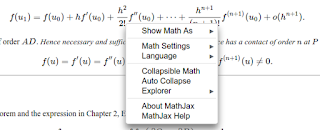HTML y Latex: MathJax
MathJax es un motor de visualización JavaScript de código abierto para la notación LaTeX, MathML y AsciiMath que funciona en todos los navegadores modernos. Para utilizar este motor, basta con agregarel código que muestro a continuación:
<script type="text/x-mathjax-config">
MathJax.Hub.Config({"HTML-CSS": { preferredFont: "TeX", availableFonts: ["STIX","TeX"], linebreaks: { automatic:true }, EqnChunk: (MathJax.Hub.Browser.isMobile ? 10 : 50) },
tex2jax: { inlineMath: [ ["$", "$"], ["\\(","\\)"] ], displayMath: [ ["$$","$$"], ["\[", "\]"] ], processEscapes: true, ignoreClass: "tex2jax_ignore|dno" },
TeX: {
noUndefined: { attributes: { mathcolor: "red", mathbackground: "#FFEEEE", mathsize: "90%" } }, Macros: { href: "{}" } },
messageStyle: "none"
});
</script>
<script src="https://cdnjs.cloudflare.com/ajax/libs/mathjax/2.7.2/MathJax.js?config=TeX-AMS_HTML-full"></script>
Los resultados son tan asombrosos como los ejemplos que muestro a continuación:
<p>
When (a ne 0), there are two solutions to (ax^2 + bx + c = 0) and they are
$$x = {-b pm sqrt{b^2-4ac} over 2a}.$$
</p>
$$\text{When }(a \ne 0)\text{, there are two solutions to }(ax^2 + bx + c = 0)\text{ and they are}$$
$$x = {-b \pm \sqrt{b^2-4ac} \over 2a}.$$
<p>
$$sum_{i=0}^n i^2 = frac{(n^2+n)(2n+1)}{6}$$
</p>
$$\sum_{i=0}^n i^2 = \frac{(n^2+n)(2n+1)}{6}$$
<p>
$$sum_{i=0}^n i^2 = frac{(n^2+n)(2n+1)}{6}$$
</p>
$$\sum_{i=0}^n i^2 = \frac{(n^2+n)(2n+1)}{6}$$
<p>
$$
begin{array}{c|lcr}
n & text{Left} & text{Center} & text{Right} \
hline
1 & 0.24 & 1 & 125 \
2 & -1 & 189 & -8 \
3 & -20 & 2000 & 1+10i
end{array}
$$
</p>
$$
\begin{array}{c|lcr}
n & \text{Left} & \text{Center} & \text{Right} \\
\hline
1 & 0.24 & 1 & 125 \\
2 & -1 & 189 & -8 \\
3 & -20 & 2000 & 1+10i
\end{array}
$$
<p>
$$underset{j=1}{overset{infty}{LARGEmathrm K}}frac{a_j}{b_j}=cfrac{a_1}{b_1+cfrac{a_2}{b_2+cfrac{a_3}{b_3+ddots}}}$$
</p>
$$\underset{j=1}{\overset{\infty}{\LARGE\mathrm K}}\frac{a_j}{b_j}=\cfrac{a_1}{b_1+\cfrac{a_2}{b_2+\cfrac{a_3}{b_3+\ddots}}}$$
<p>
$require{AMScd}$
begin{CD}
A @>a>> B\
@V b V V= @VV c V\
C @>>d> D
end{CD}
</p>
$\require{AMScd}$
\begin{CD}
A @>a>> B\\
@V b V V= @VV c V\\
C @>>d> D
\end{CD}
Un claro ejemplo donde podemos visualizar MathJax en todo su potencial es en math.stackexchange.com. Les invito a revisar el proyecto que definitivamente es de mucha ayuda a la publicación de resultados para la gente inmersa en la ciencia.

Comentarios
Publicar un comentario